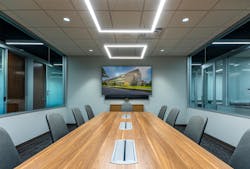Specifying furniture can be complex and overwhelming for education institutions. Facility planners have finite resources when they decide how to outfit their facilities with furniture, fixtures and equipment (FFE), so it is important to choose wisely as they carry out their furniture procurement processes.
With schools and universities nationwide allocating millions of dollars, interior designers need to avoid the pitfalls and oversights that may arise when they specify furniture. This means not only choosing the right pieces for an educational space, but also preparing the space so that potential problems can be anticipated and the FFE fits seamlessly into the space.
Because of disruptions brought on by the Covid-19 pandemic, lead times on some construction projects have increased significantly and can throw a wrench into the timeline for FFE ordering and delivery. That has forced some education institutions to revise their delivery timelines and move-in dates. But with careful coordination, management, and review, FFE budgets can see a cost savings of $2,000 to $200,000 on a single project and can even get ahead of the long lead times.
Here are five key tips to consider when navigating the obstacles that may arise in furniture selection.
Power & Data Coordination
Planners need to coordinate power sources, data connections, signage, switches and control panels during the furniture selection process. Having the wrong connections or installing them in the wrong locations may lead to several problems.
One of the most common issues is having floor boxes that have not been coordinated with a room’s furniture. Identifying the infeed and table leg type will help determine where to place a power source. The type of floor box used is just as important to coordinate. Letting a contractor know whether a table is hardwired or soft plugged is just as important as the location.
Poorly placed connections, e.g., a data port situated too far from a power outlet or behind a bookcase, can result in an awkward or uncomfortable workspace. To avoid these missteps, measure the applicable distances and clearly label them on design specs.
Designers also should make sure the planned furniture layouts of classrooms, collaboration spaces, conference rooms and private offices take into account the location of light switches and sensors. Marker boards or bookcases against walls can inhibit the operation of sensors or access to switches, so the type of furniture and where it is situated must not interfere with those functions.
Surface heights and seating coordination
Pay close attention to the apron size on built-in counters; The wrong measurements may result in inadequate leg room. Generally, it is ideal to have 10 inches to 12 inches between a seat and the bottom of a work surface apron. Mixing up counter height and bar height can cause a lot of heartache and added cost. Specifying a height-adjustable chair or stool can provide the flexibility needed to accommodate the various ranges needed for multiple surfaces. Another quick on-site fix is having the installers cut down furniture legs to accommodate the necessary height.
Specifying undercounter appliances like an ice maker and fridge also should be coordinated with the surface heights. Verify that the appliances being purchased are compliant and will fit in the space.
Elevator coordination
Whether a project is new construction or renovation, planners need to pay close attention to the size of the elevator cabs early in the specification process. A space may have ample room for large items like a conference table or a marker board, but if a furniture piece won’t fit in an elevator and is too unwieldy to make it up a stairwell, the items may never get to their destination.
On one project, the existing elevator was not large enough to accommodate the 4-foot-by-12-foot, single-piece markerboards chosen for the space. The installers had to walk them up the stairs to all four floors. Later, on the same project, the elevator car proved to be too small for the large 10-person conference tables that were specified on each of the four floors. In addition, the shape of the conference tabletops made it unfeasible for workers to bring them up the stairs. But by anticipating the elevator’s limitations, planners were able to avoid the problem. The tables were specified to be delivered in two pieces instead of one, and the elevator’s size was no longer an issue.
If furniture installation requires access to an elevator, the installation schedule needs to be coordinated with those in the facility to make sure the elevator is operational and available to workers delivering the furniture.
Detailed specification sheets
It’s all in the details when it comes to furniture specifications. Overlooking the details or missing changes made in the quantities ordered may result in not only a cost impact, but also unnecessary extra furniture. A change in the specification on recent project reduced the number of desks by three, but the change was not caught by the vendor. That could have resulted in a cost increase of $3,000 and three desks without a home. But, by combing through the quotes, the design team spotted the discrepancy before delivery.
Errors may make their way into quotes during the furniture specification process, so designers need to be vigilant about doublechecking documents. In one case, the fabric for a furniture piece was correctly specified, but it was listed in the wrong location. Had this not been caught before it was sent to production, a very different final product would have been delivered. This one piece and one fabric would have been a $12,000 mistake.
Another important specification of which to be mindful is choosing legs and glides on furnishings that are appropriate for the spaces where they will be placed. This helps avoid damage to the flooring.
Early preparation
Designers have no control over lead times, price increases, delivery complications or building setbacks, but they can ensure the specification book and quotes are prepared much earlier in the design process. The sooner that designers can start furniture selection, the sooner the orders can be placed. In a recent construction project, completion was delayed by three to four weeks, but designers had completed the furniture package and ordered it in plenty of time. Placing the order early enabled the school to avoid annual price increases and gave designers time to adjust to the changes caused by the construction delays. They were able to coordinate with installers to keep the FFE items in their packaging on site until construction was completed.
Another tip that can help cut lead times: Be aware of manufacturers’ quick ship items. During the pandemic, many manufacturers have shifted their focus and resources and prioritize keeping their popular items produced and stocked.
Furniture selection represents a long-term investment for schools and universities, and when it is done carefully and correctly, it can positively influence the experience, performance, and attitude of students and staff. Being aware of the possible pitfalls that may be encountered in the specification process will help ensure that the selection and installation of furnishings is part of a smooth and successful facility upgrade.
About the Author
Joaquin Abrego
Associate Principal of Interior Design, PBK
Joaquin Abrego RID, NCIDQ, LEED ID+C is an associate principal of Interior Design at PBK, an award-winning architecture and engineering firm. His knowledge of design, finishes and interior design enable him to be an integral part of project’s multiple phases. Joaquin’s current focus has been helping clients better understand the impact furniture has on student’s performance and well-being.
Emilee Keith
principal of interior design, PBK
Emilee Keith RID, NCIDQ is a principal of Interior Design at PBK, an award-winning architecture and engineering firm. She leads the interiors team with 15 years of experience and has a keen eye for space planning, design features and furniture projects. Emilee’s attention to detail can be seen in her meticulous modeling in construction documents and furniture management.


